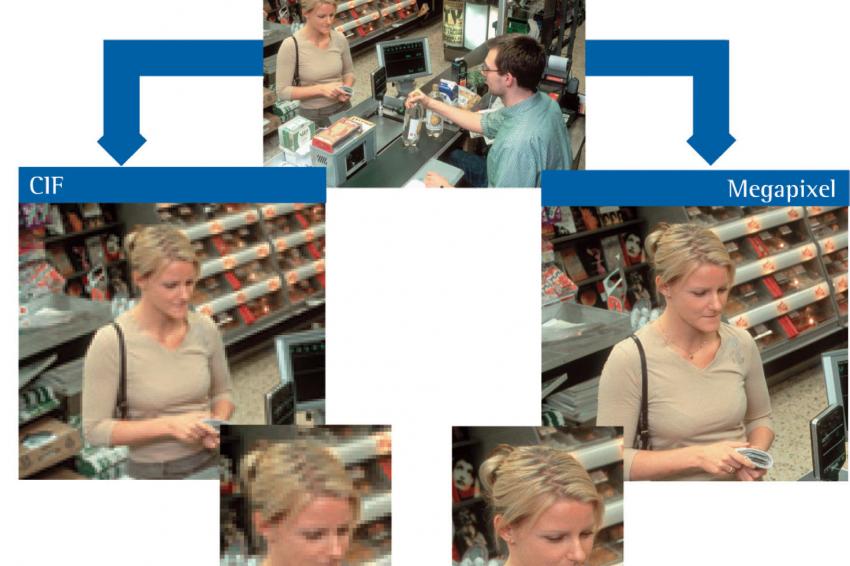Axis: network video helps to reduce shrinkage and secures shops
17.08.2012 - Axis: network video helps to reduce shrinkage and secures shops. When Axis introduced the world’s first network video camera in 1996 the company cut a lonely figure in the IP-based...
Axis: network video helps to reduce shrinkage and secures shops. When Axis introduced the world’s first network video camera in 1996 the company cut a lonely figure in the IP-based video surveillance market. Today the market for network video is booming. According to analysts, the network video surveillance market already represents about 15 % of the overall video surveillance market and is predicted to increase to 50 % in the next five years. Its growing popularity lies in the technological and cost advantages it offers. Take for example the retail market. Nearly a quarter of the overall video surveillance market is retail. Loss prevention and security are the key drivers for surveillance in this segment. This comes as no surprise considering the heavy losses retailers suffer due to shrinkage. At Axis’ global press event, Flemming Bang Dammann, Corporate Head of Security of the Dagrofa Group, gave an inside of their experience with network video in grocery stores and supermarkets.
Shrinkage, Safety and Effectiveness
The Dagrofa group is the largest wholesale supplier of groceries to Danish retailers. The company owns and operates 164 stores in Denmark and Greenland. The challenges Dagrofa faces in Denmark are pretty much the same retailers all over the world are confronting: shrinkage, safety and effectiveness. The company uses more than 900 network cameras, in a very typical way: to combat shrinkage and improve safety and security in their stores.
Retail shrinkage is defined as inventory losses occurring from employee theft, shoplifting, organised retail crime, administrative error, or vendor fraud. According to the European Theft Barometer, Danish retailers suffered approximately half a billion euros in shrinkage, amounting to 1.24 % of annual turnover. Safety is about creating a safe environment for both retail employees and customers, shielding them from serious and petty crimes from violence to pickpocketing.
With regards to effectiveness, Dagrofa understands that having fewer employees translates into a greater need for security measures. “To ensure security in our supermarkets and shops, we have a raft of security measures in place”, explains Flemming Bang Dammann. “Network video surveillance is just one of the security components but it is the one we are currently spending the largest part of our budget on because it delivers high value and addresses a broad range of our concerns.”
IP-based Network versus Analogue
When Dagrofa began its search for a new video surveillance system, it concluded that its stringent list of requirements could only be met by IP-based network video surveillance and not by analogue systems. Critically, because the in-store employees had limited time and IT-knowledge, it needed to be easy to use, reliable, and available and with the possibility for remote access over the internet. Axis’ installation tool decreased the time for installing a camera from two hours to 30 minutes and is very easy to handle – virtually plug and play.
The choice for network video was also influenced by the high quality resolution the technology offers. Digital technology provides much greater resolution than traditional analogue cameras. The picture in this article shows the limitation of an analogue camera. By zooming into a picture the face of the suspect vanishes and isn’t recognisable with the analogue camera, whereas the picture of the network video camera stayed very visible also with the zoom functionality.
“The high quality resolution of network cameras helps us to effectively investigate incidents”, said Dammann. “The good image quality had a very positive side-effect – the police are much more willing to take on an investigation if the case is well documented.”
Another reason Dagrofa choose network video was for its ability to connect the cameras to the Point of Sale system (POS). POS is a critical point for retail fraud, particularly shrinkage. Unfortunately a large part of retail shrinkage is caused by employees. If the network video is integrated with the POS system, video images from the check-outs can be linked and compared with the corresponding transaction data. This makes it possible to identify suspicious or unusual transactions, such as a large amount of manually entered values, unauthorised discounts given to customers or granting returns when there is no item returned.
“Using POS integration has several benefits. We spend less time searching for evidence and we believe there is a preventive influence on employee and customer behaviour which has translated directly to less shrinkage,” elaborated Dammann on the positive effects of their network video surveillance system. Another very important decision factor had nothing to do with the security features itself, but with economic benefits.
Dagrofa already had some legacy analogue cameras in place and was interested in re-using them to leverage the investment to improve their return on investment (ROI). With a hybrid video system this is no problem – retailers can keep on using their old analogue equipment and migrate to network video surveillance over time. During the migration, the video from the analogue cameras can be digitised and used in the network video surveillance system. The installation costs were lower too.
The cable infrastructure costs for analogue systems are almost three times higher than for IP based systems. “Dagrofa is very happy with the general advantages offered by network video,” summarises Damman. “But we won’t stop our security and safety activities here. We will continue to evaluate new technologies and network video features that support us in security and loss prevention as we evolve.”
Using Video Surveillance for Marketing
How Network Video Surveillance A pplications Increase Retailers’ Top Line Revenues
The field of applications for network video surveillance in retail is expanding. New Intelligent Video applications that help retailers to improve in-store processes, marketing and merchandising are on the rise. “We have seen during the last years a growing demand for retail specific Intelligent Video solutions that go beyond mere surveillance”, explained Johan Åkesson, director of business development, retail at Axis Communications. “Though loss prevention still is a key application for our products in retail, applications such as people counting, dwell time analysis or heat maps are becoming more and more popular.”
Combined with high resolution cameras, these applications can help retailers to improve their top-line revenues. People counting software, a common video analytics tool, is a good example of Intelligent Video. It counts the number of people entering the shop or a specific area. If a predefined number is reached, the system can send an alert to make sure that staff is allocated where help is needed. This ensures minimum waiting time and increased customer satisfaction.
This tool can also be used as an input to staff allocation schemes. Dwell time analysis and heat maps are used by retailer to evaluate and improve their merchandising and marketing activities. Dwell time refers to the time that a visitor spends in a particular location in a store. It is a metric that is used by both retailers and their suppliers to gauge the effectiveness of merchandising displays. Heat maps are used for traffic flow analysis to help the retailer understand how visitors navigate through the store.
Video analytics can automatically provide a ‘heat-map’ of the store, showing what parts of the shop experience significant customer traffic, and what parts have relatively less traffic. The information delivered by dwell time analysis or heat maps is useful for the retailer to optimise the planogram, i. e. the way how and where retail products should be displayed in order to increase customer purchases.
“Intelligent Video applications help retailers to better understand the needs of their clients and evaluate and optimise their in-sore processes and store layouts accordingly”, explained Johan Åkesson the popularity of these applications in retail. “Whereas traditional applications for network video like loss prevention help retailers to improve their bottom line revenues, Intelligent Video applications enhance the customers’ experience and increase retailers’ top line revenues.”
Contact:
Dominic Bruning
Axis Communications,
Preston, United Kingdom
Tel.: +44 870 1620 047
Fax: +44 870 7778 620
dominic.bruning@axis.com
www.axis.com











